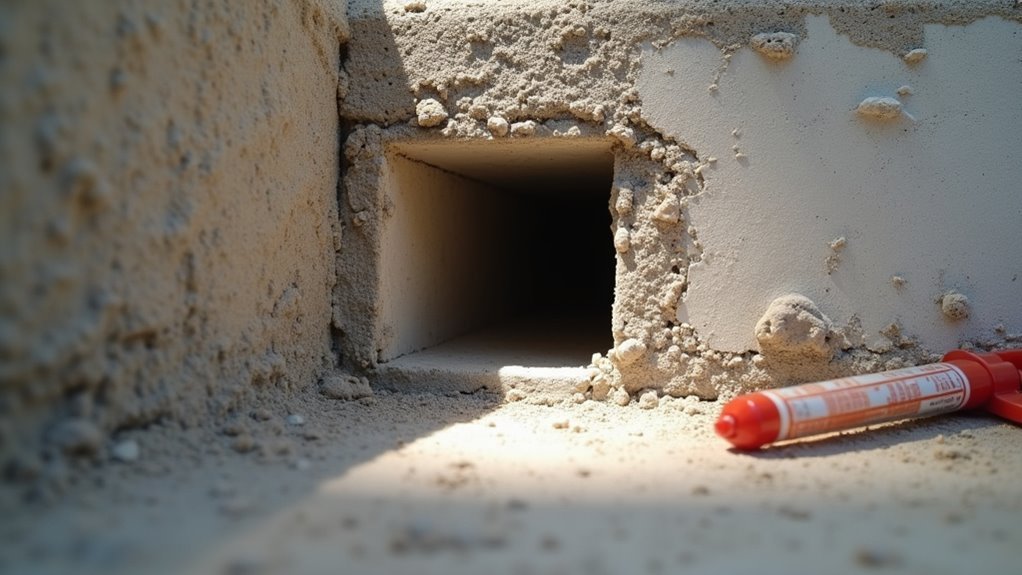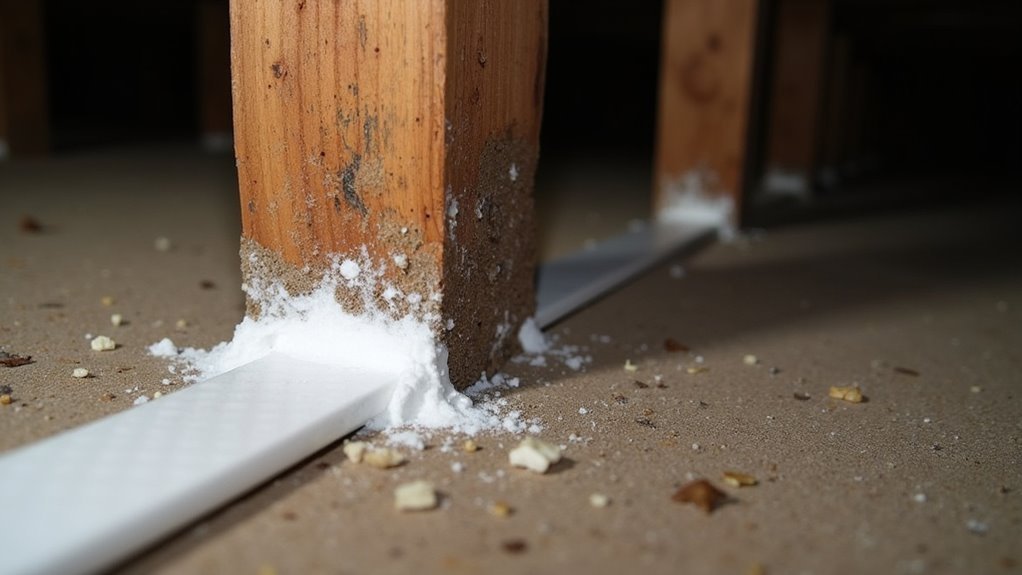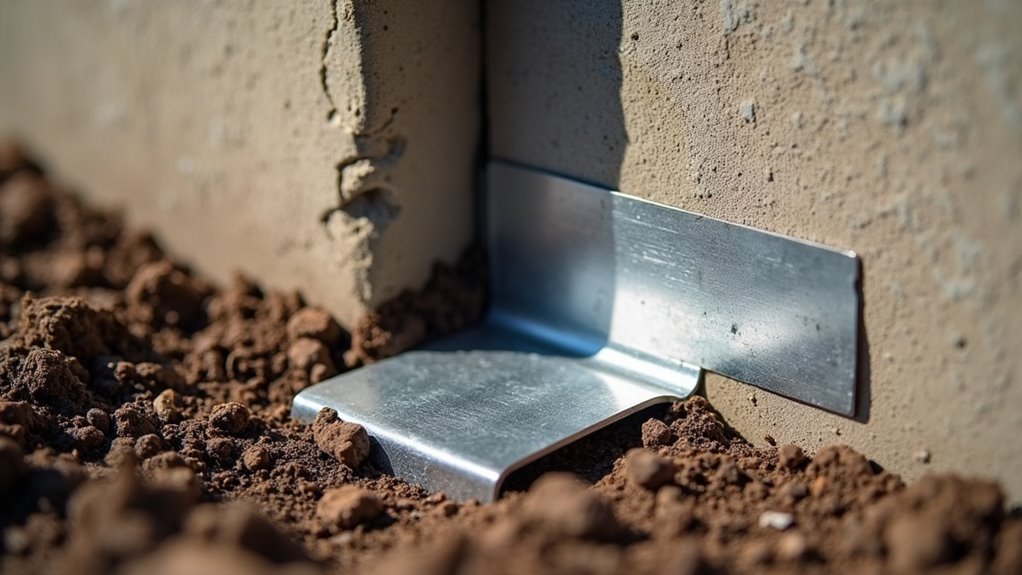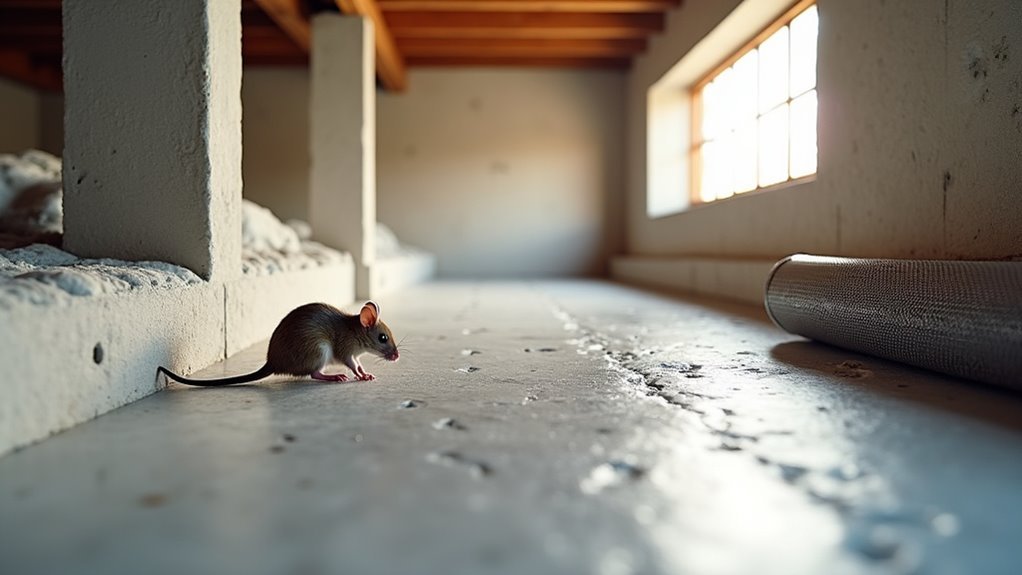You’ll need to seal foundation cracks with caulk or steel wool, install 1/4-inch hardware cloth over vents, apply weatherproof caulk around pipes and utilities, use expanding foam for gaps smaller than 1/4 inch, install door sweeps on crawlspace access points, add metal flashing around foundation penetrations, and create gravel barriers with proper drainage systems. These thorough sealing methods target every potential mouse entry point from tiny cracks to utility penetrations, ensuring your crawlspace becomes completely rodent-proof when implemented correctly together.
Identify and Seal Foundation Cracks and Gaps

When inspecting your crawlspace for potential mouse entry points, you’ll need to carefully examine the foundation for any visible cracks and gaps.
Foundation cracks and gaps, no matter how small, provide easy access routes for mice seeking shelter in your crawlspace.
Even small openings can become an entry point for mice, leading to serious infestations that compromise your crawl space care efforts and create potential health hazards.
Use effective sealing materials like caulk, expanding foam, or steel wool to close these openings permanently.
Focus particularly on areas around pipes, vents, and electrical lines where gaps commonly develop.
To identify and seal foundation cracks and gaps successfully, conduct thorough inspections twice yearly since foundation settling and weather changes create new vulnerabilities.
Regular maintenance guarantees your seals remain intact and prevents rodents from accessing your crawlspace through compromised barriers.
Install Hardware Cloth Over Vents and Large Openings
You’ll find hardware cloth to be one of your most effective barriers against mice attempting to enter through crawl space vents and larger openings.
Choosing the right mesh size and installing it properly makes all the difference in creating an impenetrable barrier that maintains ventilation while keeping rodents out.
Let’s explore how to select and install hardware cloth to maximize your crawl space protection.
Hardware Cloth Benefits
Hardware cloth stands as one of the most reliable barriers against mice infiltration in crawl spaces.
You’ll find this galvanized wire mesh offers exceptional durability with its rust-resistant properties, ensuring long-term protection unlike traditional screening materials. The 1/4-inch mesh size effectively blocks even the smallest rodents while maintaining proper air circulation throughout your crawl space encapsulation system.
You’ll appreciate hardware cloth’s cost-effectiveness at under $1 per linear foot, making it an affordable investment for thorough pest control.
When properly secured over vents and large openings, it eliminates entry points that mice commonly exploit. This proactive approach reduces your reliance on expensive pest control services while maintaining a healthier home environment.
The mesh’s galvanized coating resists corrosion, guaranteeing years of reliable performance in moisture-prone crawl space conditions.
Proper Installation Techniques
Installing hardware cloth correctly requires precise attention to positioning and securing methods that eliminate every potential entry point mice might exploit.
You’ll need 1/4 inch mesh galvanized hardware cloth to effectively block mice in crawl spaces while maintaining proper ventilation that’s essential for preventing mold growth.
Secure the hardware cloth to your vent exteriors using appropriate fasteners, ensuring no gaps remain around edges. Overlap all joints by at least one inch to create continuous barriers.
These proper installation techniques demand careful measurement and cutting to fit each opening precisely.
Check your work thoroughly, testing for loose areas that rodents could manipulate. Galvanized material resists rust and corrosion, extending your barrier’s lifespan.
Schedule regular inspections to identify wear or damage that could compromise your crawl space protection system.
Mesh Size Selection
Selecting the right mesh opening determines whether your crawlspace protection succeeds or fails against determined mice. When choosing hardware cloth for mesh size selection, you’ll need openings small enough to block these persistent rodents while maintaining proper airflow.
For effective protection against mice in your crawl space, follow these critical specifications:
- Choose 1/4-inch openings – This size prevents mouse entry while allowing adequate ventilation.
- Select galvanized steel material – Guarantees rust resistance and long-term durability against gnawing.
- Plan for double-layer installation – Combine hardware cloth with a moisture barrier for enhanced protection.
Larger mesh sizes create entry points that compromise your entire sealing effort. The 1/4-inch standard blocks mice effectively without restricting necessary air circulation, making it the best choice for crawlspace protection.
Apply Weatherproof Caulk Around Pipes and Utilities
While inspecting your crawlspace, you’ll notice that pipes and utility lines create some of the most common entry points for mice. These gaps around plumbing and electrical penetrations offer easy access to your home’s foundation.
You’ll want to use weatherproof caulk to seal gaps effectively around these utilities. Quality caulk can fill cracks up to 1/4 inch wide, which is sufficient to prevent mice from squeezing through. Choose flexible, waterproof caulk that withstands temperature changes and moisture without cracking.
Apply it generously around all pipe penetrations, electrical conduits, and cable entry points. You’ll need to inspect these sealed areas annually and reapply caulk as needed, since wear can create new openings over time.
Use Expanding Foam for Small Entry Points

For gaps smaller than 1/4 inch that caulk can’t effectively reach, expanding foam provides an excellent alternative sealing method. This sealant expands to fill tiny cracks and holes, creating a solid barrier that prevents mice from accessing your crawlspace through small entry points.
When selecting expanding foam for pest control, follow these essential steps:
- Choose rodent-resistant foam specifically designed for pest control applications to guarantee long-lasting protection.
- Clean and dry the area thoroughly before application to promote ideal adhesion and sealing effectiveness.
- Inspect sealed areas regularly for new gaps caused by temperature changes or structural settling.
You’ll find that expanding foam hardens into an impenetrable barrier, effectively blocking even the smallest access points mice typically exploit to enter crawlspaces.
Install Door Sweeps and Crawlspace Access Seals
You’ll want to focus on two critical areas when securing your crawlspace against mice: installing proper door sweeps and sealing all access points.
Door sweeps create an effective barrier at the bottom of crawlspace doors, eliminating gaps that mice commonly exploit to gain entry.
Access point sealing involves covering openings and entry points with durable seals that withstand weather conditions while maintaining their protective barrier against rodent infiltration.
Proper Door Sweep Installation
Installing door sweeps at your crawl space access points creates an essential barrier that blocks mice from squeezing through gaps beneath doors. These seals eliminate entry points while improving energy efficiency by reducing air leaks throughout your home.
Follow these steps for proper installation:
- Measure accurately – Determine the exact width of your crawl space door and select a sweep that fits snugly across the entire opening.
- Choose quality materials – Invest in durable rubber or silicone sweeps that’ll withstand weather conditions and maintain flexibility over time.
- Position correctly – Install the sweep so it makes complete contact with the threshold, leaving no gaps where pests can infiltrate.
Regular maintenance guarantees your door sweeps remain effective against rodent infiltration, so inspect them periodically for wear and replace when necessary.
Access Point Sealing
Where do most mice gain entry to your crawlspace? Through unsealed access points around doors and openings.
Access point sealing forms the foundation of effective rodent control, as mice squeeze through gaps as small as a quarter-inch. Your crawl space needs thorough sealing to prevent health risks associated with rodent infestations.
Install door sweeps on access doors to eliminate bottom gaps mice exploit.
Apply crawlspace access seals around entry points, creating tight barriers that greatly reduce rodent infiltration. Combine weather stripping with access seals for enhanced protection and improved insulation.
Regular inspection and maintenance preserve seal effectiveness.
Check for wear, damage, or gaps that compromise your barriers. This proactive approach guarantees your pest prevention strategy remains robust against persistent mice seeking entry into your crawlspace.
Apply Metal Flashing Around Foundation Penetrations

When mice target foundation penetrations as entry points, metal flashing creates an impenetrable barrier that’ll outlast any rodent’s determination to chew through it.
Unlike wood or plastic materials, metal flashing resists gnawing and provides superior protection for preventing entry around your foundation’s vulnerable spots.
You’ll find these common access points require immediate attention:
- Plumbing entries – Seal gaps around pipes with custom-fitted metal flashing
- Electrical penetrations – Cover wire entry points with properly shaped barriers
- HVAC connections – Install flashing around ductwork and utility lines
Metal flashing adapts to various foundation designs, ensuring tight seals that enhance your overall pest management strategy.
Regular inspections help you identify wear or damage, maintaining the flashing’s effectiveness in keeping your crawlspace rodent-free long-term.
Create Gravel Barriers and Proper Drainage Systems
Since moisture creates the perfect environment for mice to thrive, you’ll want to establish gravel barriers and proper drainage systems that eliminate standing water around your foundation.
Create gravel barriers by installing them around your crawl space foundation to redirect water away and reduce moisture levels that attract rodents. Install proper drainage systems like French drains to effectively manage water runoff and prevent standing water from forming unwanted habitats.
Installing gravel barriers and French drains around your foundation effectively redirects water and eliminates moisture that attracts rodents.
Place a drainage mat beneath the gravel to enhance water movement and prevent soil erosion. Elevate your gravel barrier several inches above surrounding soil to create an additional physical obstacle that’ll deter mice from accessing your crawl space.
Maintain these systems regularly to guarantee long-term effectiveness in keeping your crawl space dry and uninviting to pests.
Frequently Asked Questions
How to Seal a Crawl Space From Mice?
You’ll need to seal all cracks and holes with steel wool or caulking, install moisture barriers, close foundation vents, properly seal pipe entries, remove debris, and add bright lighting to deter mice.
What Sealant Can Mice Not Chew Through?
You can’t go wrong with steel wool, expanding foam with metal particles, heavy-duty wire mesh, concrete sealants, or properly applied silicone caulk—these materials resist mice’s chewing abilities effectively.
How Do You Seal Holes so Mice Can’t Get In?
First, identify all entry points by thoroughly inspecting areas around pipes and vents. Pack steel wool into small holes, then cover with metal flashing for larger gaps. Apply expanding foam over everything.
Do Mice Chew Through Sealant?
Mice can chew through softer sealants, but you’ll have better luck with high-quality polyurethane or silicone. They’re less likely to penetrate durable, rigid sealants, especially when you apply them thickly.
In Summary
You’ve got seven proven methods to mouse-proof your crawlspace effectively. Don’t tackle everything at once—start with the largest gaps and work your way down to smaller openings. Remember, mice can squeeze through spaces as small as a dime, so you’ll need to be thorough. Regular inspections are key since new gaps can develop over time. With consistent application of these sealing techniques, you’ll keep those unwanted rodents out permanently.





Leave a Reply